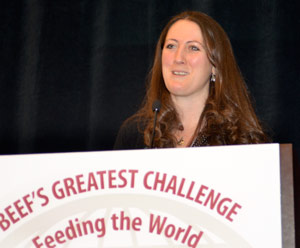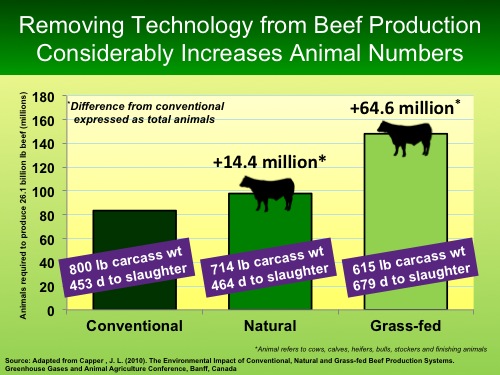ILC–USA 2012
Beef's Environmental Impact
Efficiency is the key to reducing the beef industry’s environmental impact.
by Kasey Miller, API associate editor
DENVER (Jan. 10, 2012) — With inevitable population increases, total meat consumption will increase by about 70% by 2050, said Jude Capper of Washington State University at the 2012 International Livestock Congress in Denver, Colo., Jan. 10. With this increasing global population will come increasing global incomes, which will mean more demand for animal protein. The challenge, then, is to produce more protein on less arable land, while still reducing the environmental impact for future generations.
 Jude Capper photo by Kasey Miller
Jude Capper photo by Kasey MillerCapper said she is optimistic that these challenges can be met by increasing the efficiency of the beef cattle industry. Efficiency, she added, is something the industry does well already.
When anti-agriculture groups claim that the beef industry is negatively affecting the environment, she counters with an example likening the claim to that of fuel efficiency in cars. A vehicle hauling 50 passengers that gets 5 miles to the gallon on a 500-mile trip ultimately gets 250 "people miles" per gallon. She compared that to a vehicle, also traveling 500 miles, that gets 35 miles to the gallon but only carries four passengers. It ultimately gets 140 "people miles" per gallon.
We need to assess efficiency on an output basis, Capper asserted. "It's not about the size of the animal, but about the pounds produced, about the output," she said.
From 1977 to 2007, the beef industry improved output per beef animal, Capper emphasized. In 1977, it took five animals to produce the same amount of beef as it took four animals to produce in 2007. It also took 124 fewer days to raise a market-ready animal, saving those days of land, feed, water, fertilizer and transportation use, plus compiling less manure.
To quantify those efficiency effects further, from 1977 to 2007, beef yield increased by 131%. Achieving the increased production required 70% of the animals, 80% of the feed, 88% of the water and 67% of the land that would have been required at 1977 production levels. Manure production decreased to 82%, as did methane, and nitrous oxide and carbon footprint levels were 88% and 84% of 1977 levels, respectively. These numbers take into account cows, heifers and bulls, not just feedlot cattle.
“Those gains were achieved by improving productivity and efficiency,” Capper noted.
 While asserting that there is a place for every system of beef production, she said that when comparing conventional, natural and grass-fed beef production systems, conventional does have the highest amount of efficiency based on days using natural resources. To produce an 800-pound (lb.) carcass, it takes 453 days to slaughter. A natural system produces 714 lb. of carcass and takes 464 days to slaughter, and a grass-fed system produces a 615-lb. carcass in about 679 days. Those additional days are using land, feed and water while creating waste.
While asserting that there is a place for every system of beef production, she said that when comparing conventional, natural and grass-fed beef production systems, conventional does have the highest amount of efficiency based on days using natural resources. To produce an 800-pound (lb.) carcass, it takes 453 days to slaughter. A natural system produces 714 lb. of carcass and takes 464 days to slaughter, and a grass-fed system produces a 615-lb. carcass in about 679 days. Those additional days are using land, feed and water while creating waste.
Capper offered some tips on increasing efficiency, which will lower the beef industry’s environmental impact:
• Reduce time to reach target weights by increasing growth rate and feed efficiency, using beef performance technologies and optimizing diet formulation.
• Minimize losses within the system by reducing morbidity and mortality and reducing parasite infestation.
• Improve reproductive efficiency by aiming for one live calf per cow each year.
• Increase land carrying capacity with improved pastures and better forage varieties.
• Reduce postharvest resource use and emissions, including water, paper, plastics and styrofoam.
While these may seem simple, she said, they will build upon each other.
Capper concluded, empasizing one major point: Environmental impact should be assesed with sound science practices, not ideological principles and “touchy-feely” thought processes as many anti-agriculture groups are wont to use.
Click here to view Capper's PowerPoint presentation.
For additional coverage of ILC–2012, return to the ILC index page.
Editor’s Note: The above article was written under contract or by staff of Angus Productions Inc. (API). It may not be reprinted without express permission of API. To request reprint permision, contact the editor at 816-383-5200.
This section of the API Virtual Library contains event coverage provided by the editorial team at Angus Productions Inc. (API), publisher of the Angus Journal, the Angus Beef Bulletin, the Angus Beef Bulletin EXTRA and the Angus e-List. For questions about this site, to submit an article for our consideration, or to report a broken link, contact the editor at 816-383-5200; 3201 Frederick Ave., Saint Joseph, MO 64506.
API claims copyright to this website as presented. We welcome educational venues and cattlemen to link to this site as a service to their audience.






